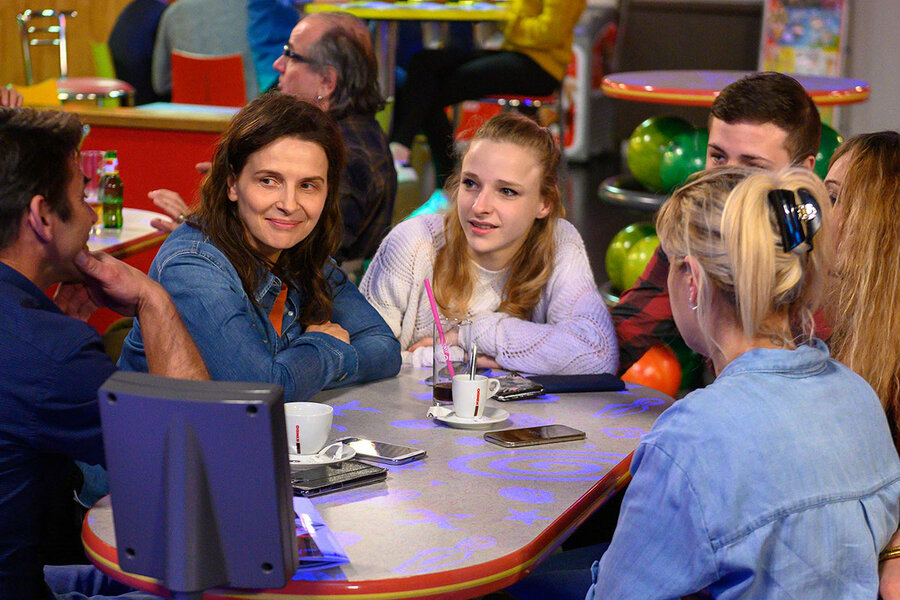
When we first see Marianne Winckler (Juliette Binoche) in the compelling new French film “Between Two Worlds,” she is wearily waiting her turn in a long line at a government unemployment center in the northern port city of Caen. She looks to be somewhat older than most of the women there, including Chrystèle (Hélène Lambert), a single mother of two, who loudly rails against the authorities for mishandling her benefits.
Marianne has more than a passing interest in these proceedings. She tells her government interviewer that she is a housewife whose husband has left her. But, as we soon learn, Marianne is actually a well-known writer based in Paris. Her intention is to go undercover as a cleaning lady to investigate firsthand for a book what it’s like to survive with minimal pay and no job security during a countrywide economic crisis. She wants to personalize the headlines and “make the invisible visible.”
Directed by the acclaimed writer and filmmaker Emmanuel Carrère, who co-wrote the screenplay with Hélène Devynck, “Between Two Worlds” is loosely adapted from Florence Aubenas’ nonfiction 2010 bestseller “The Night Cleaner.” Aubenas is a celebrated journalist perhaps best known worldwide for having been kidnapped and held captive for five months in 2005 while covering the Iraq War.
Why We Wrote This
A story focused on
The undercover journalist in the film “Between Two Worlds,” loosely based on a true story, finds the hardship she expects from jobs with minimum pay. But she also discovers something else: friendship and joy.
In the film, unlike in Aubenas’ book, the writer infiltrates the workforce without revealing her true identity to anyone. This development introduces an additional element of uncertainty: How ethical is Marianne’s ploy, and how will her co-workers, several of whom become fast friends, react to the news when they inevitably discover the truth?
Even when playing nonglamorous characters, Binoche has often exuded a faintly luxe air. In this film, which Binoche initiated, that trace of sophistication is altogether appropriate given Marianne’s real history. I wish the movie had gone further into her backstory. By contrast, the workers with whom she congregates are sharply delineated. Most of them are played by an extraordinary corps of nonactors drawn from a hardscrabble world not unlike the one depicted in the film. We are made to feel the hurts and wants of these laborers in an overpoweringly personal way. But Marianne remains something of a glorified stand-in for the audience. The moral tilt of the story – Is she a fraud for posing as a worker? – is less interesting than the depiction of the friendships and day-to-day struggles of these women. It is in these moments that “Between Two Worlds” truly resonates.
The filmmakers show us the soul-killing drudgery of the workers’ lives. We see the women, and some men, toiling each night as they clean out the cabins of a channel-crossing ferry – all 230 rooms, four minutes per room. (The men, it is dryly noted, “don’t do bathrooms.”) We glimpse, without any editorializing, the long line of Sudanese immigrants lining the docks and looking for work in the nighttime hours. Carrère, wisely I think, doesn’t turn the film into a reformist anthem. Shooting in a semidocumentary style, he allows us to absorb, along with Marianne, the relentless accretion of injustices.
He also gives us some of the most believable portraits of female friendship I’ve ever seen in a movie. This closeness, shown without a smidgen of sentimentality, serves as the saving grace of these women’s lives. Its impending disruption gives the film its tragic dimension. Marianne and Chrystèle and the winsome Marilou (Léa Carne), buffeted but unbowed, become a kind of valiant trio. Like the extraordinary Lambert, Carne, who is also portraying a life close to her own, had never acted professionally before. This background helps explain why the performances radiate such amazing authenticity.
When the women go bowling together or giddily find themselves stowed away inside a first-class ferry cabin, their momentary exhilarations reveal the reservoir of joyousness that, despite everything, somehow sustains them. In moments like these, Marianne, the poseur, becomes one with them. Her duplicity seems much less an affront than an affirmation of hope.
Peter Rainer is the Monitor’s film critic. “Between Two Worlds” is unrated and starts rolling out in theaters Aug. 11. It is in French with English subtitles.
